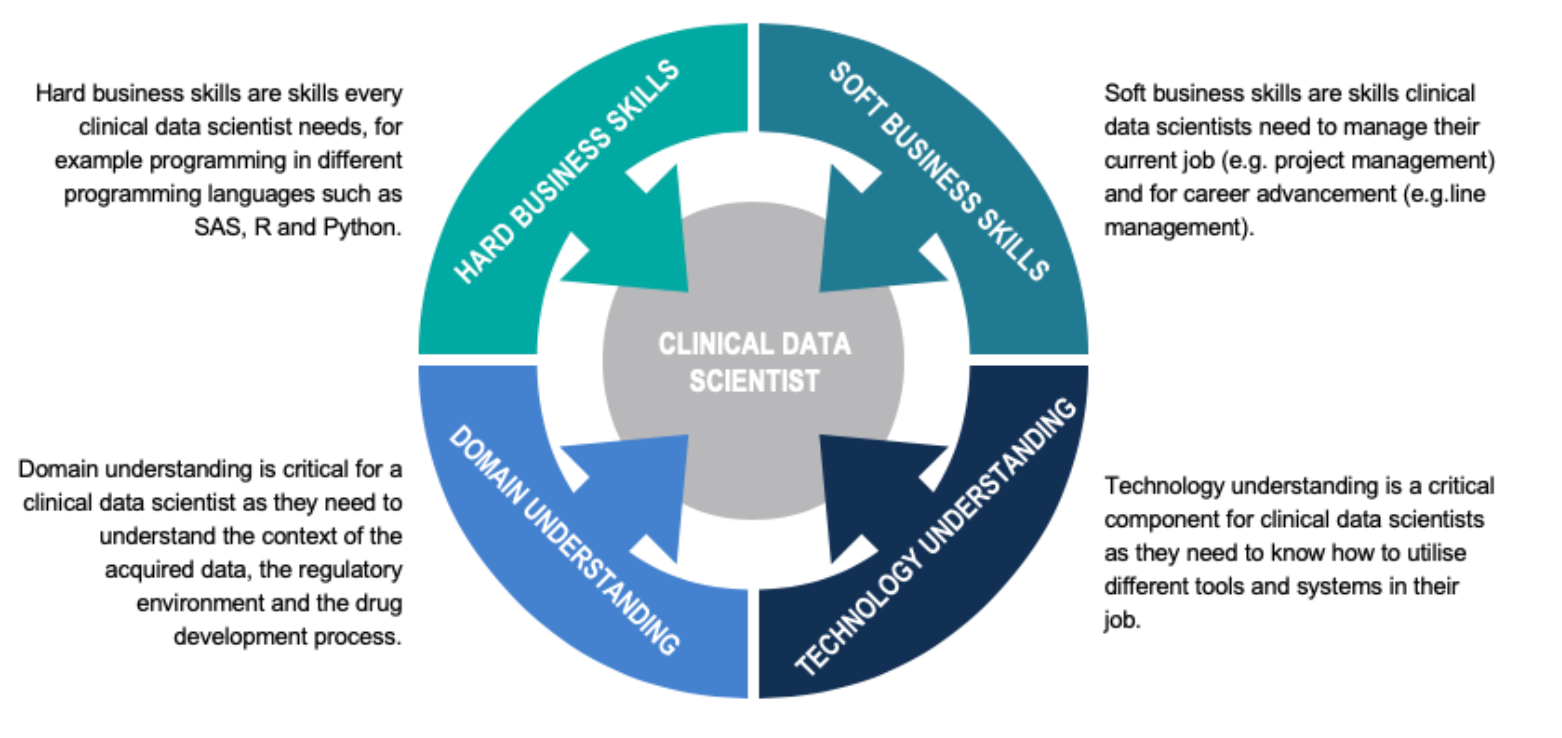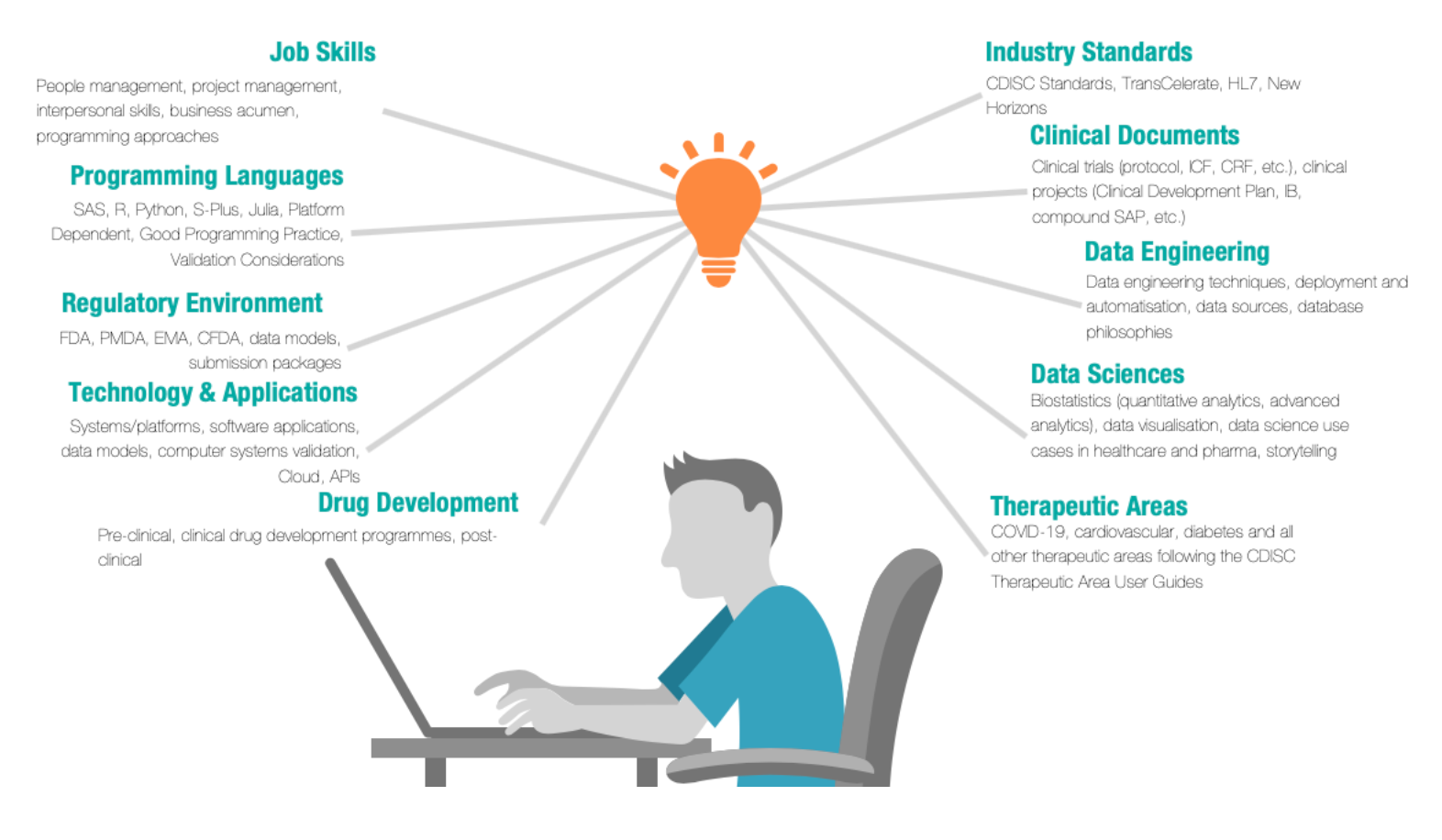Sascha Ahrweiler, PHUSE Education Director
In June’s Webinar Wednesday, PHUSE Founder and Chairman of the board, Stephen Bamford, gave an update on all things PHUSE. One important piece of this state of the union webinar was a brief introduction to our new Education strategy. What Stephen had already shared received great feedback as it meets industry needs. In times of digital transformation, where every industry is fighting for data science talent, the pharma and CRO industry, as well as software providers, all go through the same challenges. Education has become a major challenge within our rapidly changing environment in regards to technology and methodology around clinical data.
With our new PHUSE Education strategy, we strive to support the PHUSE community with ongoing self-educational efforts. Since its beginning, the open sharing of knowledge, connecting talent and advancing clinical data science has been at the heart of PHUSE. In this blog, I want to share further detail about how PHUSE’s Education framework has been designed to close the relevant gaps in what we do.
Since our inaugural conference back in Heidelberg in 2005, we have collected more than 2,000 papers and presentations from our Connect events in Europe and the US. With more than 150 Single Day Events, the number of presentations has also grown way beyond the 1,500 presentations. Lastly, the PHUSE Working Groups have produced a large bank of white papers and documents of regulatory relevance since our first-ever Computational Science Symposium back in 2012.
I would like to give a big thank you to all our PHUSE members. We are gratified to have such a great archive of widespread industry knowledge covering programming languages, technology and applications, as well as other job skills for continuous personal and professional development.
For those who are not only new to PHUSE, but every new colleague in our industry, it has become a major challenge in connecting the dots in all our PHUSE efforts, which is necessary to understand the bigger picture of the industry to then be able to work effectively in the area of clinical data science.
The vision of PHUSE Education is to create a PHUSE roadmap to education, which covers the broad bandwidth of knowledge a clinical data scientist needs to have to be successful in their job. This covers both hard and soft skills, as well as technological understanding and, most importantly, a thorough domain understanding. While there may be a lot of commonalities in data science methodology within clinical data science and marketing data science, the way in which we acquire data from very selective patient populations, data privacy concerns and regulatory-compliant traceability necessities makes the work of a clinical data scientist different. Therefore, understanding the domain is of critical importance.

Earlier this year, we brought together various educational groups, such as the Educating for the Future Working Group and the Knowledge Repository group, to align how we could manage these challenges. With this group of thought leaders, we have identified ten educational clusters, which cover the broad bandwidth of expertise a clinical data scientist needs to have for their job. This includes fundamental requirements such as various programming languages or central data science skills such as biostatistics. Besides that, regulatory environment, drug development or therapeutic areas are contained for this critical domain understanding.
 The figure above provides an overview of all ten clusters, accompanied by a couple of sub-topics for each cluster.
The figure above provides an overview of all ten clusters, accompanied by a couple of sub-topics for each cluster.
Our thought leaders have outlined the content that each cluster will need to cover. In our next steps we will bring all our educational volunteers together to help us in consolidating our combined expertise. With the help of our educational volunteers who previously supported the various Educating for the Future, the Knowledge Repository or the Machine Learning Working Groups, we will now collect and curate existing educational material, combine it to form the big picture and translate it into our domain wherever necessary. We will provide overviews of each cluster, and important sub-clusters, as well as provide tangible use cases and tutorials focussed on our clinical domain. For example, you are able to find hundreds of training resources on learning Python, but when it comes to how Python can be used in the clinical domain, there are just singular examples available. We’ll find these examples and consolidate them. If we cannot find high-quality examples, our innovative volunteers will translate existing material into our domain.
It is important to understand that these educational clusters can be easily combined in one shape or form. Therefore, the close collaboration of all educational clusters is of essential importance. The topic “Visualisation in R of Quality of Life data” would be a great example for the Programming Languages cluster. On the other hand, with an introduction to the general methodology of data visualisation, it is also a very good example for the Data Visualization sub-cluster in the Data Science cluster.
The Programming Languages cluster, in particular, will make use of the technical tool Jupyter Notebooks, which is used widely by data scientists to document their work and make it traceable for other data scientists to reproduce results. Jupyter Notebooks contains both computer code (e.g. Python) and rich text elements (paragraphs, equations, figures, links, etc.). Notebook documents are both human-readable documents containing the analysis description and the results (figures, tables, etc.), as well as being executable documents which can be run to perform data analysis. With this approach, we kill two birds with one stone: the PHUSE community will become familiar with using Jupyter Notebooks, and we will extensively lower the barrier in learning a programming language as interactive as Jupyter Notebooks because you do not necessarily require any application installation.
Everything we produce in the PHUSE Education group will be presented in a consolidated and digestible manner on our website. Plenty of resource material from the PHUSE archive and our Working Groups, combined with recommended reading (e.g. books and articles), listening (e.g. audiobooks or podcasts) or viewing (e.g. videos or films), will create a profound source of valuable educational material to dive deeper into the rabbit hole of clinical data science education.
Our PHUSE Education volunteers deeply benefit from their involvement. Researching available educational material, consolidating it and presenting it in a way that others can learn from it is the best way to grow yourself in an area of your choice. The critical feedback of our industry thought leaders aids in keeping the quality of everything we present on our website to a high standard.

We will closely collaborate with the Working Groups and help them to stay focussed on closing relevant gaps in the regulatory environment and framework. In the past, socialising and implementing Working Group deliverables was an additional burden on the busy shoulders of the groups. Our education groups will be able to support these areas and help to put Working Group deliverables into the overall bigger picture.
In his state of the union talk, Stephen Bamford also introduced the new PHUSE supporter model, which will see the transition from ‘Membership’ to ‘Community’ and feature PHUSE Signature supporters, who are an integral part of our PHUSE Education strategy. With annual updates on our PHUSE Education strategy and roadmap, we will actively search for feedback from industry leaders to set the right priorities. With this, our PHUSE supporters will help drive the education strategy and align it with the challenges the entire industry is facing both today and tomorrow.
I hope this short blog provides more insight into the thrilling ride that has just taken off at PHUSE. What do you think about the PHUSE Education strategy? Please leave us a comment below or send us an email with your feedback. We would love to hear from you!
Get involved
Do you want to become a part of this exciting new journey for PHUSE? We welcome every volunteer who would like to join us to actively work on educational topics. Let us know your area of interest and we will be sure to find a challenge for you.
If you want to provide specific software where you think a close collaboration could lead to mutual benefits for both you and PHUSE Education, we will find ways of how to facilitate this and create value.
In both cases, please feel free to send an informal email to education@phuse.global, to become a member of our PHUSE Education group as a volunteer or collaborator.
